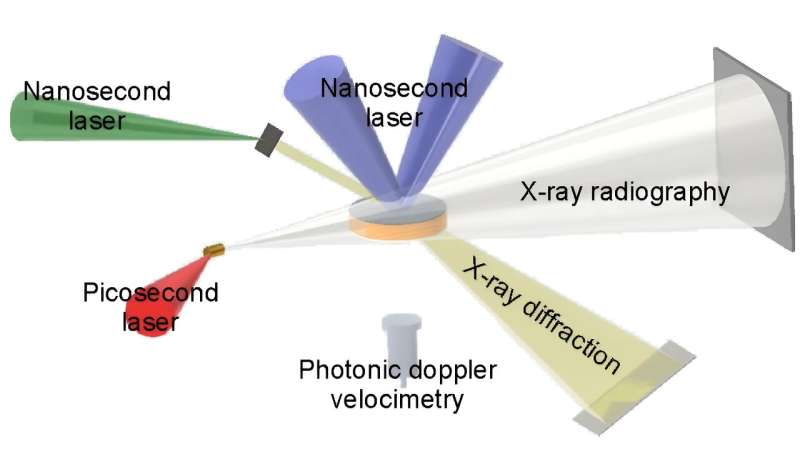This article has been reviewed according to Science X's editorial process and policies. Editors have highlighted the following attributes while ensuring the content's credibility:
fact-checked
proofread
Research progress in pump-probe experiments at high-intensity laser facilities

The reaction kinetics of energetic materials is a key factor in determining the detonation characteristics and safety. The complexity of the reaction process and the lack of experimental means remain a notable challenge in experimental research and fine modeling. To accurately predict the detonation and safety properties of energetic materials, it is necessary to clarify the reaction mechanism and dynamic process.
Pump-probe experiments conducted at large laser facilities provide various flexible load and probe combinations for the study of the reaction kinetics and dynamic process of high explosives in a wide temporal and spatial range. In a review published in Energetic Materials Frontiers, a group of researchers from China outlined the studies of large laser facilities, advanced pump-probe experiments methods and the progress.
The team of scientists presents preliminary results of overdriven detonation, dynamic flyer imaging, dynamic explosive X-ray diffraction, and excited-state dynamics. Furthermore, they outlined the methods used to investigate the internal deformation, phase transition, and ultrafast dynamics under dynamic loading at high spatial and temporal resolutions, which have the potential for unraveling the complexity of explosive reaction kinetics.
"These experiments represent a significant challenge since it is essential to develop a new generation of in situ diagnostics for angstrom- to millimeter-scale lengths," says lead author Gen-bai Chu.
"The ultimate goal of pump-probe experiments that combine both optical and X-ray (or other particles) probes is to achieve the femtosecond imaging of chemical reactions at material surfaces and interfaces or buried within a compressed sample with an atomic-scale spatial resolution."
The authors identified four crucial steps. First, micron-sized explosives drive a tunable pressure range from low-pressure ignition to overdriven detonation by laser loading.
Second, high-resolution transient X-ray radiography allows the study of the microstructural evolution of high-energy explosives under dynamic loading and was of great importance for the performance optimization of explosive foils, as well as the design of new and reliable initiating devices.
Third, important factors in understanding the ignition and detonation mechanisms of explosives include the crystal structure, phase fraction grain size and chemical reaction products of explosives under dynamic loading.
Finally, ultrafast laser spectroscopy enables the study of structural, geometrical and chemical changes upon electronic or vibrational excitation.
"Going forward, pump-probe experiments can be used to study complex reactions involving the coupling effect of chemical reactions and shock waves to obtain in-depth understandings of bond breaking/formation, local energy populations and their redistribution, changes in structure and stoichiometry, phase separation, and kinetics under dynamic loading," concluded Chu.
More information: Gen-bai Chu et al, Recent progress in research on the dynamic process of high-energy explosives through pump-probe experiments at high-intensity laser facilities, Energetic Materials Frontiers (2023). DOI: 10.1016/j.enmf.2023.06.003
Provided by KeAi Communications Co.





















